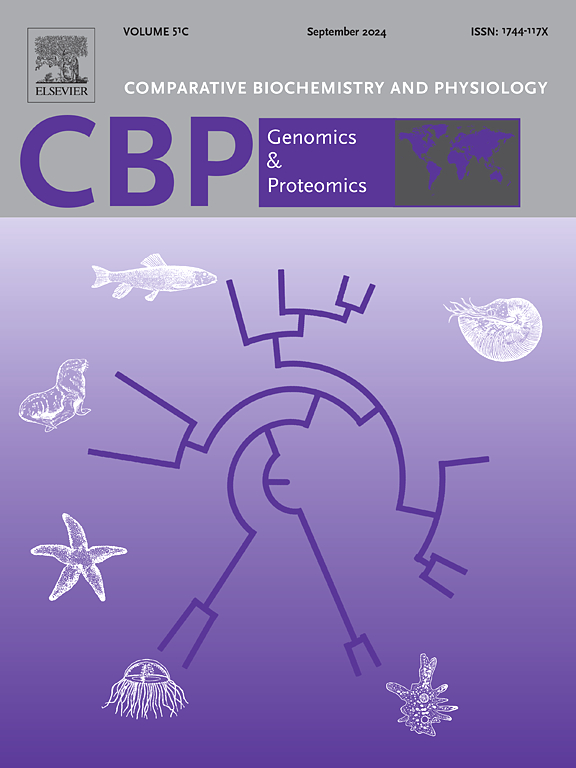Identification of the changes of immune response, morphology, and gene expressions in hepatopancreas of Macrobrachium nipponense under the treatment of alkalinity exposure
IF 2.2
2区 生物学
Q4 BIOCHEMISTRY & MOLECULAR BIOLOGY
Comparative Biochemistry and Physiology D-Genomics & Proteomics
Pub Date : 2025-05-24
DOI:10.1016/j.cbd.2025.101546
引用次数: 0
Abstract
Macrobrachium nipponense exhibits limited alkali tolerance, restricting its cultivation in the predominant saline-alkaline water resources of China. Understanding the molecular and physiological mechanisms underlying alkaline acclimation is critical for enhancing its environmental adaptability through genetic improvement. This study comprehensively examines the hepatopancreatic responses of M. nipponense to alkaline stress (10 mmol/L) through integrated analyses of antioxidant enzyme activities, histological alterations, and transcriptomic profiling analysis. Results demonstrate that alkali stress significantly elevates the activities of superoxide dismutase (SOD), glutathione peroxidase (GSH-PX), total antioxidant capacity (T-AOC), and Na+/K + -ATPase, suggesting their crucial role in mitigating oxidative damage, caused by the alkaline exposure. Histopathological analysis reveals structural alterations in the hepatopancreas after 96 h of exposure, particularly in luminal integrity, vacuolization, and storage cell morphology. Transcriptomic profiling analysis indicates minimal differential gene expression at this alkalinity; however, KEGG analysis identifies key enriched metabolic pathways, including fatty acid biosynthesis, fatty acid metabolism, insulin signalling pathway, and AMPK signalling pathway, as central to the adaptive response. These pathways are closely associated with energy metabolism, implying their regulatory significance in alkali acclimation. Quantitative real-time PCR validation confirms the transcriptomic data, ensuring methodological reliability. This study provides novel insights into the physiological and molecular adaptations of M. nipponense under alkaline stress, offering a foundation for future functional studies and marker-assisted breeding. Further research will focus on characterizing candidate genes and identifying associated single nucleotide polymorphisms (SNPs) to advance genetic enhancement in this species.

碱化处理下日本沼虾肝胰腺免疫应答、形态及基因表达变化的研究
日本沼虾耐碱能力有限,制约了其在中国盐碱水资源优势地区的种植。了解碱驯化的分子和生理机制是通过遗传改良提高其环境适应性的关键。本研究通过综合分析抗氧化酶活性、组织学改变和转录组学分析,全面研究了日本沼虾对碱性胁迫(10 mmol/L)的肝胰反应。结果表明,碱胁迫显著提高了超氧化物歧化酶(SOD)、谷胱甘肽过氧化物酶(GSH-PX)、总抗氧化能力(T-AOC)和Na+/K + - atp酶的活性,表明它们在减轻碱胁迫引起的氧化损伤中起重要作用。组织病理学分析显示暴露96小时后肝胰脏的结构改变,特别是在管腔完整性、空泡化和储存细胞形态方面。转录组学分析表明,在该碱度下,差异基因表达最小;然而,KEGG分析确定了关键的富集代谢途径,包括脂肪酸生物合成、脂肪酸代谢、胰岛素信号通路和AMPK信号通路,它们是适应性反应的核心。这些途径与能量代谢密切相关,在碱驯化过程中具有重要的调控作用。定量实时PCR验证确认转录组数据,确保方法的可靠性。本研究为日本稻在碱性胁迫下的生理和分子适应提供了新的认识,为今后的功能研究和标记辅助育种奠定了基础。进一步的研究将集中在候选基因的表征和鉴定相关的单核苷酸多态性(snp),以推进该物种的遗传增强。
本文章由计算机程序翻译,如有差异,请以英文原文为准。
求助全文
约1分钟内获得全文
求助全文
来源期刊
CiteScore
5.10
自引率
3.30%
发文量
69
审稿时长
33 days
期刊介绍:
Comparative Biochemistry & Physiology (CBP) publishes papers in comparative, environmental and evolutionary physiology.
Part D: Genomics and Proteomics (CBPD), focuses on “omics” approaches to physiology, including comparative and functional genomics, metagenomics, transcriptomics, proteomics, metabolomics, and lipidomics. Most studies employ “omics” and/or system biology to test specific hypotheses about molecular and biochemical mechanisms underlying physiological responses to the environment. We encourage papers that address fundamental questions in comparative physiology and biochemistry rather than studies with a focus that is purely technical, methodological or descriptive in nature.

 求助内容:
求助内容: 应助结果提醒方式:
应助结果提醒方式:


